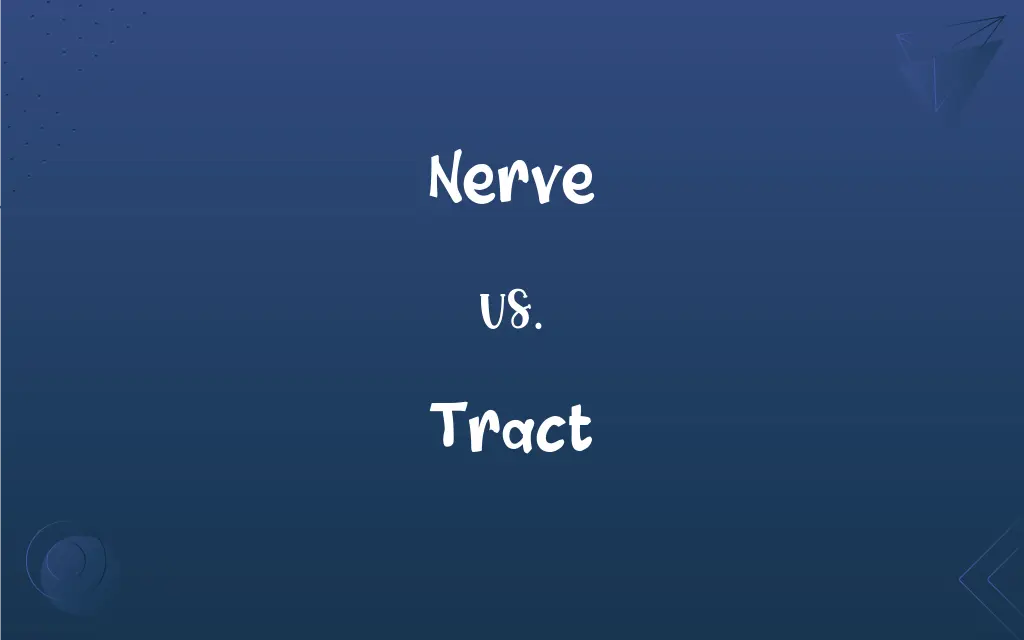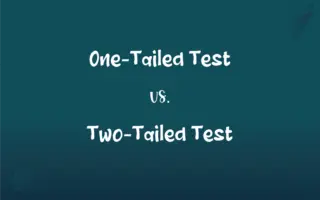Nerve vs. Tract: What's the Difference?
By Aimie Carlson & Harlon Moss || Published on March 13, 2024
Nerves are bundles of axons in the peripheral nervous system; tracts are axon bundles within the central nervous system.

Key Differences
Nerves and tracts both consist of axons, which are the long, slender projections of neurons that transmit electrical impulses. However, nerves are part of the peripheral nervous system (PNS) and extend from the central nervous system (CNS) to various parts of the body, facilitating communication between the CNS and limbs, organs, and tissues. Tracts, on the other hand, are found within the CNS, which includes the brain and spinal cord, and they serve to relay information from one part of the CNS to another.
The main structural difference between nerves and tracts lies in their location and the protective coverings around the axons. Nerves are encased in protective sheaths that aid in their repair and regeneration, while tracts are not individually protected but are instead housed within the brain or spinal cord. This difference reflects the distinct environments in which they operate and their specific roles in neural communication.
Nerves are involved in both sending sensory information to the CNS from the body and transmitting motor commands from the CNS to muscles and glands. Tracts, however, are primarily responsible for relaying information within the CNS, including between the brain and spinal cord or within different parts of the brain.
The categorization of axon bundles as either nerves or tracts is a reflection of the organization of the nervous system. This distinction is crucial for understanding how sensory, motor, and cognitive information is processed and transmitted throughout the body.
The ability of nerves to regenerate to some extent after injury contrasts with tracts, where damage can result in more permanent loss of function due to the limited regenerative capacity within the CNS. This difference has significant implications for medical treatment and recovery from nervous system injuries.
ADVERTISEMENT
Comparison Chart
Location
Peripheral nervous system
Central nervous system
Composition
Bundles of axons with protective sheaths
Bundles of axons without individual protective sheaths
Function
Transmit sensory and motor information
Relay information within CNS
Protective Covering
Myelin sheath and connective tissue
Located within brain or spinal cord, no additional covering
Regeneration
Capable of some regeneration
Limited regeneration capacity
ADVERTISEMENT
Nerve and Tract Definitions
Nerve
A bundle of axons in the PNS transmitting signals between the CNS and body.
The sciatic nerve conveys information from the spinal cord to the leg.
Tract
Does not possess individual protective sheaths.
Tracts are vulnerable to damage due to their location in the brain or spinal cord.
Nerve
Encased in protective sheaths for damage repair.
Peripheral nerves have a remarkable capacity for regeneration after injury.
Tract
Facilitates complex cognitive functions.
The anterior cingulate tract is involved in emotion and decision-making.
Nerve
Includes sensory and motor fibers.
Nerves like the facial nerve carry both sensory information and motor commands.
Tract
Implicated in many neurological conditions.
Multiple sclerosis can damage tracts in the CNS, leading to various symptoms.
Nerve
Can be affected by various disorders.
Neuropathy involves damage to peripheral nerves, affecting sensation and movement.
Tract
Integral for processing and relaying information.
Motor tracts in the spinal cord coordinate muscle movement.
Nerve
Essential for reflex actions.
Reflexes are mediated by nerve pathways that bypass the brain.
Tract
A bundle of axons within the CNS connecting different brain regions.
The corpus callosum is a large tract connecting the two cerebral hemispheres.
FAQs
How do nerves and tracts contribute to reflex actions?
Nerves transmit signals to and from the CNS, enabling reflexes, whereas tracts relay information within the CNS to coordinate these responses.
What role do tracts play in the brain?
Tracts connect different brain regions, facilitating communication and integration of cognitive, sensory, and motor functions.
Why are tracts less capable of regeneration?
The CNS has a limited regenerative capacity, making tract damage often more permanent and challenging to treat.
Can technology repair damaged nerves or tracts?
Advances in medical science, such as nerve grafting and stem cell therapy, offer potential for repairing nerve damage, but options for tract repair remain limited.
What is the significance of myelin sheaths in nerves?
Myelin sheaths enhance the speed and efficiency of electrical signal transmission along the nerve axons.
What distinguishes a nerve from a tract?
Nerves are bundles of axons in the PNS with protective sheaths, while tracts are similar bundles within the CNS without these sheaths.
Are all nerves myelinated?
Not all nerves are myelinated. Some nerves, particularly those responsible for slow signal transmission, lack myelin sheaths.
How are disorders affecting nerves and tracts diagnosed?
Disorders are diagnosed using a combination of clinical assessments, imaging techniques, and sometimes nerve conduction studies or biopsies.
Can nerves regenerate after injury?
Yes, nerves in the PNS have some capacity for regeneration, though the extent depends on the severity of the injury.
What are some common causes of nerve injury?
Nerve injuries can result from trauma, compression (e.g., carpal tunnel syndrome), exposure to toxins, diseases (e.g., diabetes), and inflammation.
How do diseases like multiple sclerosis affect tracts?
Diseases like multiple sclerosis damage the myelin sheaths of CNS axons, disrupting the normal function of tracts and leading to neurological symptoms.
How do tracts differ in their direction of information flow?
Tracts can be ascending (carrying sensory information to the brain), descending (carrying motor commands from the brain to the spinal cord), or interconnecting (linking different areas within the CNS).
How do genetic conditions affect nerves and tracts?
Genetic conditions can affect the development, structure, or function of nerves and tracts, leading to various neurological disorders, such as Charcot-Marie-Tooth disease or hereditary spastic paraplegia.
What are the main types of nerves in the PNS?
The main types include sensory (afferent) nerves, which transmit signals from the body to the CNS; motor (efferent) nerves, which convey commands from the CNS to muscles; and mixed nerves, which carry both sensory and motor fibers.
Why is the study of tracts important in neuroscience?
Understanding tracts helps in diagnosing and treating neurological disorders, as well as in research on brain function and mapping neural connections.
How do medical professionals test nerve function?
Nerve function is tested through nerve conduction studies, electromyography, and sensory tests to assess the integrity and performance of the nerve fibers.
How does the body respond to tract injuries in the CNS?
The body's response is limited by the CNS's restricted ability to regenerate, often leading to scar formation and the potential for long-term functional deficits.
What impact does nerve damage have on the body?
Nerve damage can result in loss of sensation, movement, or function in the affected area, leading to conditions like paralysis, numbness, or neuropathic pain.
Can tracts be visualized using medical imaging?
Yes, techniques such as Diffusion Tensor Imaging (DTI) allow for the visualization of tracts within the CNS, aiding in the study of brain connectivity and pathology.
What advancements are being made in nerve repair?
Research in nerve repair focuses on techniques like nerve grafting, neurotrophic factors, and stem cell therapy to enhance regeneration and functional recovery.
About Author
Written by
Aimie CarlsonAimie Carlson, holding a master's degree in English literature, is a fervent English language enthusiast. She lends her writing talents to Difference Wiki, a prominent website that specializes in comparisons, offering readers insightful analyses that both captivate and inform.
Co-written by
Harlon MossHarlon is a seasoned quality moderator and accomplished content writer for Difference Wiki. An alumnus of the prestigious University of California, he earned his degree in Computer Science. Leveraging his academic background, Harlon brings a meticulous and informed perspective to his work, ensuring content accuracy and excellence.































































